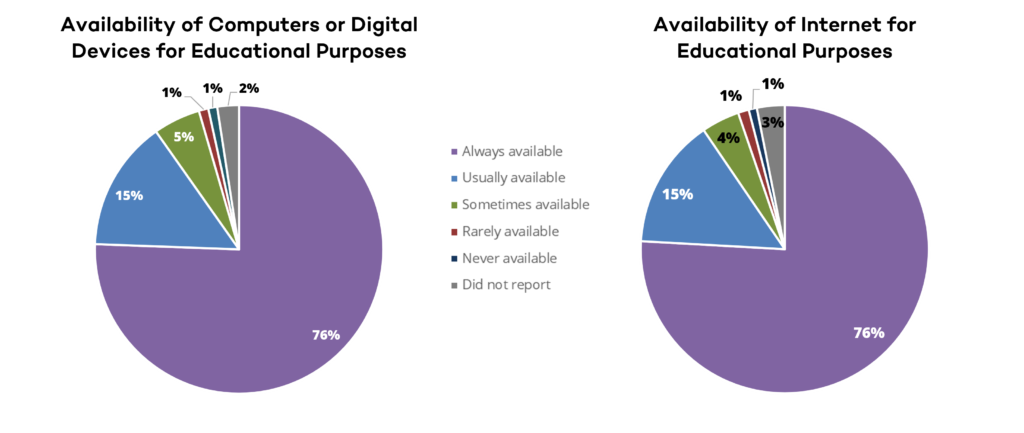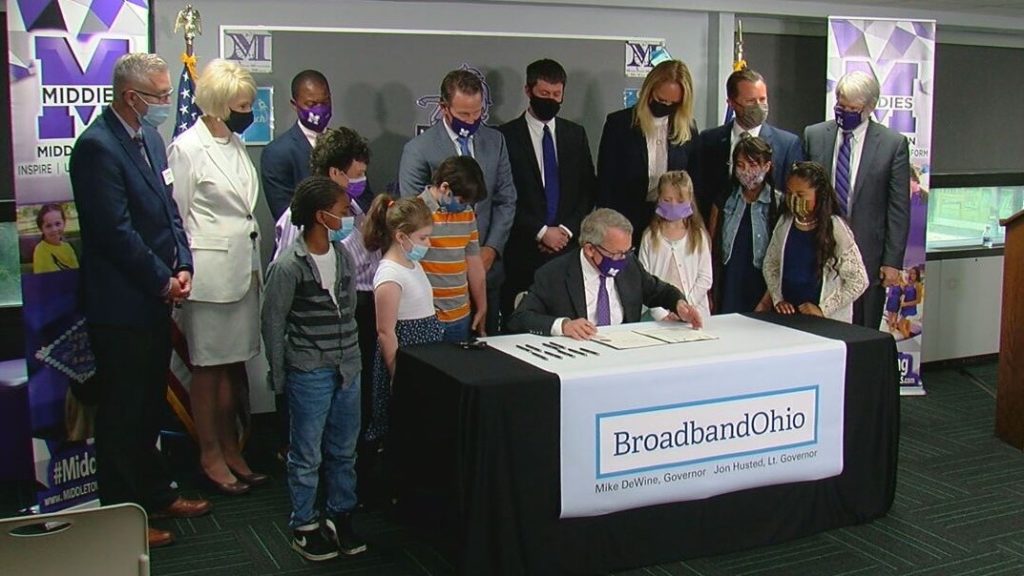Affordable, reliable internet access has never been more essential to a student’s education. Governors recognize that the COVID-19 pandemic underscored the urgent need for distance learning and closing the digital divide for K-12 students.
By Catherine Van Ness and Jake Varn
In 2019, many state leaders celebrated the closing of the digital divide in schools, with 99 percent of schools able to support digital learning with their broadband access. In 2020, students and teachers suddenly found themselves outside of those school buildings and many went searching for the internet access they needed to be able to carry on with their education. While some parents found themselves working from home and sharing internet bandwidth with their children’s virtual classrooms, others found themselves in library and restaurant parking lots in search of free Wi-Fi signals.
Public schools and libraries will receive a temporary benefit from the recent release of more than $7 billion from the Federal Communication Commission’s (FCC’s) Emergency Connectivity Fund, which was included in the American Rescue Plan Act. The FCC’s Emergency Broadband Benefit also has provided relief for nearly 4 million individual households since the program opened in May. While these programs will provide much-needed temporary relief, there is still more work to be done to provide long-term solutions.
Governors have prioritized permanently closing the digital divide and are acting swiftly by harnessing federal and state dollars, making transformative policy changes, and working closely with key stakeholders. Access to high quality, affordable broadband unlocks access to commerce, work opportunities, remote and improved K-12 and postsecondary education, telehealth, precision agriculture, enhanced utility services and connected infrastructure, and more. As part of the National Governors Association’s series on the importance of affordable broadband access in all aspects of life, we are spotlighting Governors’ efforts to explore longer-term solutions, leveraging state, federal, private and anchor institutions to provide support as students continue learning.
According to the June 2021 household pulse surveys from the Census Bureau , of the 44 million U.S. households with children in public or private school, over 9 million do not always have access to a computer for educational purposes and nearly 9 million do not have internet access. Analysis from Common Sense Media and Boston Consulting Group has found this digital divide is more severely pronounced in Southern and more rural states, and most present among low-income families, with half of disconnected students in families with annual incomes less than $50,000, and disproportionately among Black, Latino and Native American students, representing 40 percent of the total student population but 55 percent of the disconnected students. An online survey of more than 82,000 K-12 students from the nonprofit YouthTruth, found the digital divide is particularly pronounced among Latino students, with 30 percent reporting a lack of reliable internet access as an obstacle to distance learning, compared to 23 percent of peers in the survey.

Governors Leading on K-12 Digital Access
Since the onset of the pandemic, Governors have made connecting more students with internet access and devices a priority. In early 2021, 40 Governors emphasized the need to expand broadband access in their state of the state addresses, with at least 30 highlighting the urgent need to better connect students and improve digital education tools.
Throughout this period, NGA has highlighted a variety of policy levers Governors have used to address broadband access for educational purposes, including:
- Partnering with internet service providers (ISPs) to provide service and devices at free or reduced costs;
- Deploying mobile hotspots in underserved areas;
- Coordinating with institutions, nonprofits and philanthropists to ensure students can access computers and tablets for free or at a reduced price; and
- Developing long-term broadband connectivity in underserved areas with new and existing networks.
Further, NGA’s May 2020 memo on supporting virtual learning environments detailed Governors’ policy options to directly support remote teaching and learning, including by creating a centralized site for student and faculty resources, providing dedicated support for learners with disabilities, and waiving complicating requirements such as restrictions on virtual mental health counseling. These policy levers, along with NGA’s 2020 report on Governor Strategies to Expand Affordable Broadband Access, have proven critical to prevent further learning loss during the pandemic and enable more wide-spread digital access for both remote and in-person K-12 education. NGA also partnered with the COVID Collaborative, the Council of Chief State School Officers and the Council of the Great City Schools to produce a guide to address comprehensive student and educator needs in remote and hybrid settings.
State Successes in Bridging the Digital Divide for K-12 Students
State examples of success include the dedication of $10 million in Governor’s Emergency Education Relief funds by NGA Chairman and Arkansas Governor Asa Hutchinson to fund Wi-Fi access points and data plans for all school districts in the state. The state signed agreements with providers AT&T and T-Mobile to purchase up to 20,000 hotspot devices, with unlimited data on fixed plans of about $20 per month per device. NGA Vice Chairman and New Jersey Governor Phil Murphy also celebrated fully bridging the K-12 digital divide in March by ensuring devices and connectivity for all enrolled students after overcoming supply-chain challenges. At the start of the pandemic, it was estimated that approximately 231,000 of the state’s nearly 1.4 million public school students needed either devices, internet connectivity or both. Through New Jersey’s Digital Divide Grant program, each of those students were connected to the resources they needed.
Under the leadership of New Mexico Governor Lujan Grisham, state agencies worked closely with ISPs to promote low-cost services, establishing 1,250 Wi-Fi hotspots and providing thousands of laptops and hotspots to students. Connecticut Governor Ned Lamont announced that the state would provide a learning device to every PK-12 student in need, including 144,000 laptops and 44,000 at-home internet connections. As a part of New York Governor Andrew Cuomo’s Reimagine New York Commission, Schmidt Futures and the Ford Foundation launched ConnectED NY, an emergency fund to provide free internet access for approximately 50,000 K-12 students across New York through the 2021-22 school year.
In support of permanently closing the digital divide, Governors have announced new, historic investments in broadband infrastructure for schools and underserved communities. Ohio Governor Mike DeWine arrived at Amanda Elementary School in Middletown, Ohio to sign new legislation creating the state’s first Residential Broadband Expansion Program with $20 million in grants to offset construction costs to facilitate expansion of high-speed internet. Similarly, Oregon Governor Kate Brown’s proposed budget included an $118 million investment in broadband expansion, with more than $10 million dedicated to expanding connectivity for schools that lack sufficient broadband services. With nearly 92 percent of students learning remotely or in a hybrid setting during the 2020-21 school year, Illinois Governor JB Pritzker recognized the urgent need to close the digital divide and disbursed $80 million in grants to local districts that were then able to purchase devices and expand connectivity to better serve their students.
Governors are also actively deploying new federal funds to better connect students. At the beginning of the 2020-21 school year, Alabama Governor Kay Ivey dedicated $100 million from the federal Coronavirus Aid, Relief, and Economic Security (CARES) Act funding to create the Alabama Broadband Connectivity (ABC) for Students program. ABC for Students provided a voucher for free internet service to all households with K-12 students who qualify for the National School Lunch Program by entering into negotiated contracts with eligible internet service providers. By the end of December 2020, ABC for Students reached more than 200,000 students through 42 internet service providers, providing a minimum of 25mbps/3mbps speeds.
In August 2020, Delaware Governor John Carney announced the allocation of $20 million in CARES Act funding to support new broadband infrastructure and services for low-income students. With these funds, the Delaware Department of Technology and Information partnered with the state’s Department of Education to create the Connect Delaware subsidy program to provide free fixed and hotspot broadband connections to qualifying low-income students in the state through the 2021 school year. All of the state’s 19 school districts and 23 charter schools participated in the program, requesting nearly 26,000 products to date.
North Carolina Governor Roy Cooper announced plans to dedicate $1.2 billion in American Rescue Plan Funds, with $600 million to build infrastructure, $420 million to promote federal affordability programs (such as the FCC’s Emergency Broadband Benefit program) and to continue subscription support following the sunsetting of federal programs, and $165 million to provide households with devices and support digital literacy programs.
South Carolina Governor Henry McMaster, co-chair of NGA’s Task Force on Economic Recovery and Revitalization, allocated $50 million of the 2020 CARES Act funding to broadband services. One of the funded projects, in Allendale, South Carolina, leveraged donated equipment from private companies to install public Wi-Fi networks at the Allendale Elementary School, the University of South Carolina Salkehatchie campus and a local library, and built a local network on the newly available citizens broadband radio service (CBRS) spectrum that can reach upwards of 1,000 households.
A similar CBRS network has been constructed in Utah by the Salt Lake City-area Murray School District, making it the first school district in the nation to offer free LTE broadband access, and the district has plans to expand the network to reach the homes of all of its 6,000 students. According to the Consortium for School Networking, school districts in New Mexico, Colorado and Texas, and additional districts in Utah, are in the process of setting up their own private wireless networks.
“Without access, students are unable to participate in remote learning. They’re often unable to do their homework if they are in school in-person. They are also more likely to disengage and fall behind.”
Governor Jared Polis
Prior to the pandemic, in 2016 the Boulder Valley School District utilized Colorado’s ConnectME pilot program to partner with the provider LiveWireNet to provide qualified families in the free-and-reduced lunch program to receive free internet services. In 2020, the school district was able to expand access to more than 1,000 families through a combination of hotspots and direct-to-home fiber service, exchanging school real estate and dark fiber access to the provider for free services to qualified households. The school district also will receive 25 percent of the provider’s gross revenue (estimated to net the district $200,000 to $300,000). In November 2020, Governor Jared Polis announced the Connecting Colorado Students Grant Program, a public-private partnership with internet service providers and community organizations to provide internet access for students, educators and staff, with a priority for funding school districts with a high percentage of students on free and reduced lunch. The program began with $2 million in funding and was expanded to $20 million in 2021. One grant recipient, the St. Vrain Valley School District in Longmont, is creating new public Wi-Fi areas, reviving a decommissioned wireless network in the city, and expanding the city’s fiber network, NextLight, which provides free service to income-qualified students.
A recent survey of nearly 400 K-12 IT leaders by the Consortium of School Networks found efforts to expand broadband access outside of school have increased dramatically, with 51 percent of district tech leaders reporting providing off-campus internet services in 2020, prior to the pandemic; by April 2021, the rate nearly doubled to 95 percent. According to the survey, the most popular strategy has been to provide district-owned hotspots, with 70 percent of respondents reporting the deployment of these devices, and 27 percent reported providing home internet access through free or subsidized programs for low-income families.
During the COVID-19 pandemic the divide between those with and those without internet access has shifted from being narrowly framed as a “homework gap,” to a full disconnect from the classroom itself. Prior to the pandemic, Governors made tremendous strides improving the internet connections in schools, reaching the landmark figure of 99 percent of America’s K-12 schools having access to high-speed internet in 2019, many through state-operated networks. As schools prepare for a return to in-person instruction this fall, the need for students to have internet access at home will persist, along with the need for students to have access to the necessary devices and digital skills. Without these, the homework gap will inevitably rewiden. While the use of digital educational tools and remote learning will in many cases be scaled back, they will remain components of the K-12 educational landscape. The investments Governors made during the pandemic, and continue to make during this period of recovery, have directly connected millions of students and will continue to unlock new digital educational opportunities for years to come.
NGA will continue to provide resources and best practices on these efforts as NGA Chairman Arkansas Governor Hutchinson launches a new 2021-22 initiative on expanding computer science education in K-12 schools.













